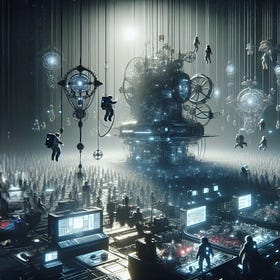A Short History of Digitalization
Preliminary thoughts on the Short Circuiting of History
To assist our readers, both old and new, in gaining a better understanding of what makes Burckhardtian thinking so relevant to the enigmas of our current world, we’ve decided to serialize our English translation of Eine kurze Geschichte der Digitalisierung, published in 2018. It’s important to note how he presents in it a narrative about the drive of our current Social Drive [Gesellschaftstriebwerk]. While this drive may seem like something new, its roots trace back to when the Greek Alphabet [Typenrad] coalesced into the foundation of our Occidental opening, often referred to as the Greek Miracle or, more despairingly, as Eurocentric Colonialism. However, that is another story, one which we’ve been discussing on Ex nihilo since its inception. Our real hope is to use this serialization as a springboard for a series of conversations between us about how this labyrinth of thought is interconnected and can provide a lens for envisioning a path toward into an open future.
On a personal note, this was the first text Martin gave me to read and translate when he decided to take me on his journey first as a student, then as his colleague—meaning it’s what I initially cut my teeth on, as he began teaching me what I’ve come to call Burckhardtian Thinking. Hopefully, it’ll give you the same access. Also, a special thanks to Dr. Mark Jacobson, who was our reader of this translation.
And, as always, the following is a co-translation by Martin Burckhardt & Hopkins Stanley
— Hopkins Stanley
A SHORT HISTORY OF DIGITALISATION
PRELIMINARY THOUGHTS
Everyone is talking about »Digitalisation.« However, what lies behind this term remains a great unknown—despite the intimate relationship we have with our smartphones. If you ask where computers come from, the answer is usually: ›from calculating machines,‹ or there is an awkward silence. Surprisingly, this lack of knowledge affects not only the users, who see no reason to explore the inner workings of their favorite devices, but also programmers, whose job it is to endow machines with functionality, if not »intelligence.« This creates a strange rupture in society, where one side of the public celebrates the Machine as a heavenly Jerusalem, while another demonizes it as an abyss. However, such religious disputes have little to do with reality. Torn between heaven and hell, we find ourselves in the cloud, a mental limbo where nothing is certain anymore in the middle of what’s often referred to as the Value Crisis.
Marx predicted that everything »standing and permanent will evaporate,« and any diagnosis of the present can only conclude soberly that so-called reality is in the process of disintegration: a Potemkin village that, not coincidentally, is producing more and more »Fake News.« A few years ago, it was still possible to believe that Digitalisation was flanged onto [angeflanscht]1 the World like a kind of Second Life, we now realize: We're stuck in the net, one way or another, here and now. And that is our life.
However, this process is not a curse imposed by a higher power. Au contraire: Digitisation is a human endeavor. Unlike our interactions with Nature, we’re no longer confronted with inert matter, the unpredictability of objects, or other challenges. If we encounter a limitation, it resides in our own understanding, our lack of imagination—or our sheer ignorance of the rules and languages that govern the Digital World.
When I recount the »Short History of Digitisation«, my impulse is driven by an effort to capture the history of our World's social and cultural transformation, where our lack of understanding, fairy tale beliefs, and half-knowledge can threaten to suffocate us. The greatest misconception is the assumption that it's a tool to be mastered and wielded like a hammer. No, the computer isn’t something you can Master; rather, it is a society-spanning architecture, an intellectual Cathedral which has developed over several centuries.
If you allow yourself to be drawn into this story, which is sometimes humorous but always deeply human, a new image of modernity emerges: one in which Digitalisation no longer appears as a cold demon. For it’s not the sky that limits us, but the human Power-of-Imagination [Einbildungskraft].
Martin Burckhardt
Fall 2018
1 – FROM THE SHORT CIRCUIT OF HISTORY
Every prehistory is dark – and so you shouldn’t be surprised when your child asks if you actually lived through the Stone Age. But we don't have to go back that far; only to the year 1746, which is also long before my time. And yet, I claim that it is in this otherwise relatively uneventful year that the Internet entered the world. Please? What do you mean? Yes, that sounds crazy. Of course, someone will protest, saying, »What Nonsense! What about Tim Berners-Lee?« But patience! Because as we search for the roots of the digital age, we will not be following the general heroic story, but the real ›Spirit of the Machine‹ – exactly where we actually find our miraculous story of the analog-to-digital conversions beginning.
Imagine standing in an open field in Northern France. Six hundred monks form a large circle, binding each other together with iron wire. After the monks form up, one of them, Abbé Jean-Antoine Nollet, touches a vessel. And what happens? Not just one—no, all monks begin to twitch simultaneously! What sounds as esoteric as chair backs and incantations isn’t a mysterious cult but strictly a scientific experiment. It was discovered that electricity could be stored in the so-called Leyden jar, a glass container filled with water and electrified by friction. Equipped with this battery, the question was how quickly the wondrous substance could travel through this human circuit. Would it elicit a kind of movement from one connection to the next, similar to the spectator Wave we see at sporting events?
Originally, it was assumed that the current, perceived as a fine liquid, would spread like a rapid tidal wave. Hence, the experimental design was arranged: a large, wide field and numerous monks forming a circle about 600 meters in diameter. Nevertheless, the outcome was surprising, as the monks all began to twitch simultaneously without any noticeable delay. This had to mean that the moment the spirit left the bottle, electricity was everywhere! How amazing! And yet, it was also quite disturbing at the same time
Even the first observations made with this strange force were extremely puzzling. Almost forty years earlier, Stephen Gray, a textile dyer and amateur astronomer, noticed that the glass cylinder he rubbed with wool or cat hair suddenly had the peculiar effect of attracting the loose goose feathers lying around the room and sticking to it. So, what do you think you do when you’ve trapped a ghost in a bottle? You plug the bottle with a cork.
Of course, this wasn’t the way to deal with the ghost. When Gray went to use his cork for another purpose, he discovered that this mysterious attraction had transferred to the cork – as it was now attracting goose feathers as well. Gray then attached hemp strings to the cork top to see if the ghost could shimmy along those strings to different points in the room. In subsequent experiments, the strings, which he called »lines of communication,« became longer and longer. It turned out that, while the strange force could be transmitted through many materials to any point, it couldn’t be transmitted through every material. Wood and glass, for instance, were completely insensitive, while copper wire exhibited particularly high conductivity. Consequently, in 1729, Gray succeeded in bridging a greater distance with the help of a silk-wrapped copper wire. When he now touched the electrified glass cylinder, pieces of gold leaf rose at the other end of the wire, dancing like butterflies around an ivory ball. Of course, the question was: How does the human body relate to this moving force of attraction? Is it conductive or not?
To find out, Gray hung a boy in a rope construction, electrified him using a charged glass tube, and had the child place his fingertips on brass plates. Since the boy was hanging from a non-conductive wooden frame, it was clear that the human body could be animated and there had to be something like animal electricity. Very soon, these experiments turned into a fashionable pastime, with the cavaliers of science demonstrating that sparks could be drawn from young women's heads, lettering made to glow, and the like.
But what does all this have to do with our computer world and the Internet? Aren’t we digressing here and going down the rabbit hole? Strictly speaking, it’s precisely this very digression that is our topic. The experiment with the monks was a radical extension of Gray's experiments; the difference being that for the first time, the question of speed is in the foreground. The experimenter, Abbé Nollet, had already demonstrated the power of a Leyden jar to the French king by sending a whole company of his soldiers into convulsions. His monks were given the dual role of both electrical conductors and sensors, whose twitches would indicate whether the spirit force had captured them or not. The fact that all the monks started twitching at the same time made it seem as if this force removed the distance, since it appeared simultaneously at all points of the circle. But how was this possible? What kind of force could effortlessly bridge the space?
It’s easy to imagine how this question confused people, especially as current science calibrated its natural laws, such as the falling of apples in relation to gravitational forces. In fact, philosophers claimed that the world was nothing more than a great Machine, a Machina Mundi. Therefore, it was only logical to regard living beings as natural automatons, whose minds functioned precisely and incorruptibly like clockwork. If you had knowledge of the position and speed of all parts in the universe, you could reliably calculate not only every past but also every future state of the world. This beautiful regularity was now struck by the lightning of electricity, akin to a divine miracle—or alternatively, as a heavy cloud threatening to darken the bright sky of the Enlightenment. In any case, this cloud resurrected all the old occult questions. Personified in the philosopher Swedenborg, whose work gathered a strange pandemonium of angels and spirits, various questions returned with the power and intensity that had occupied Medieval theologians. During that time, the question people speculated about was how fast angels could move. And as exemplar, they proposed that an angel traveling from Barcelona to Milan over a distance of 978 kilometers moved so swiftly that hardly more than two raindrops would touch it in a downpour. Assuming a duration of 1 second, we arrive at an average speed of an impressive 3,520,800 km/h or one three-hundredth of the speed of light, the speed at which electric particles travel through a vacuum.
But what does all this have to do with the Internet? By attempting to determine the speed of electricity, Abbé Nollet's experimental designs anticipate the question of 20th-century relativity – the coupling of the speed of light and real time, where the possibility of remote action is already factored in. Was it possible to trigger an action occurring many kilometers away at the touch of a finger? At that time, when horsepower and a carriage were used for distant travel, this was a tremendous and, above all, completely strange idea. However, if we are being honest: don’t we ourselves have difficulties imagining such simultaneity? Thus, the question becomes, how long does it take an electrically charged particle to travel from point A to B on the first integrated chip from 1961? This question is nothing more than a reformulation of Nollet's experiment – except that the monks are referred to as transistors here and their distance from each other has shrunk to 0.15 micrometers. The answer: if a meter is defined as the distance light travels in a vacuum in 1/299,792,458 seconds, the particle requires only one hundred-thousandth of this 299 billionth of a second – in other words, such a short period that we are unable to practically capture it in our thinking. Ultimately, it makes no difference whether we imagine the angels of the Middle Ages, the monks of Abbé Nollet, or transistors on a computer chip. For us, the flow of time is no longer a factor. This is precisely the meaning of the strange term real time. This means that although electrical particles travel at a speed, they cannot be perceived by our senses. Because humans can hardly perceptually capture more than 30 images per second, we can claim an observational simultaneity, that is, as real time – although this is not strictly physically correct. In this respect, there is no difference between the electrified monks of Abbé Nollet and the transistors of a computer chip. One could speak of the human processor of Abbé Nollet. As with the angels of the Middle Ages, who were brought up to speed by the monks of the 18th century, it is ultimately a question of acceleration and, as you can see, of reduction. This is precisely where the progressive speeding up of our lives lies. In the Middle Ages, when people wondered how many angels could fit on the head of a pin, the question of modern processor architecture was: how many monks (transistors) can I fit on a chip?
Angeflanscht [flanged-mounting] is a plumbing term used to describe the attachment of a fitting to reinforce and provide additional strength, sometimes used similarly to how we talk about jerry-rigging. Here, it refers to how Digitalisation was initially seen as a simple game extension into the virtual world where users could buy virtual space in Second Life, as a further play on Nietzsche’s Hinterweltlern/Hinterwälder [Backworldsman] of the Hinterwelt [Backworld] pun in Thus Spoke Zarathustra. However, we’re now gradually waking up from our long sleepwalk, only to discover it’s not the Trans-humanist transcendental dream but rather a symptom of the »here and now« of our first life: that, like it or not, we’ve transitioned from a World of Representation into a Networked one with a completely different toolkit we’re learning to use. (See Nietzsche, F. – Thus Spoke Zarathustra, trans. Thomas Common, New York, 1917, pp. 28-32.)
Related Content
The Psychotope
The following text appeared in German in Lettre International, No. 146, Autumn 2024. Since the Universal Machine and its Psychotope are such central leitmotifs to Burckhartdian thinking, we’ve translated the text for our English readers.
Audiobücher / Audiobooks
Hier kann sich der geneigte Leser einige durchaus liebevoll produzierte Hörbücher zu Gemüte führen / Here the reader can listen to some lovingly produced audio books








